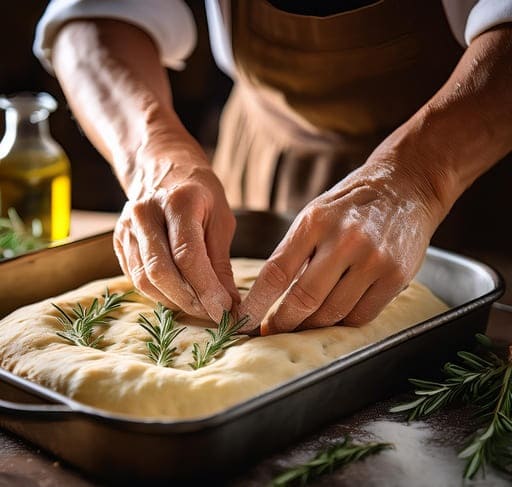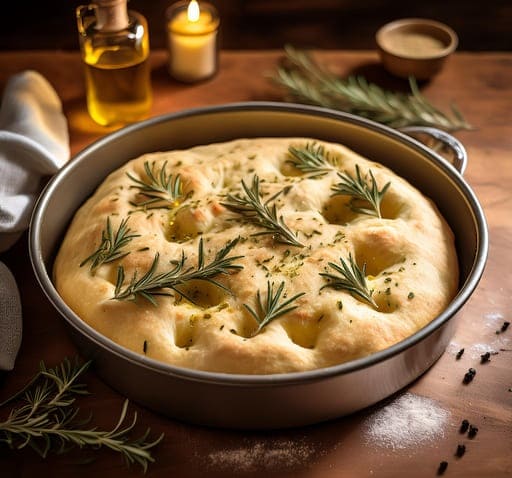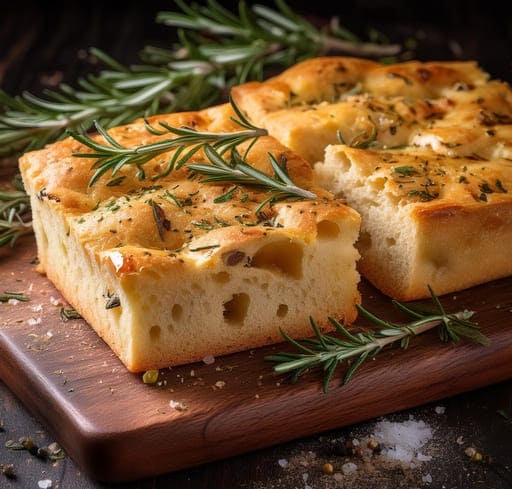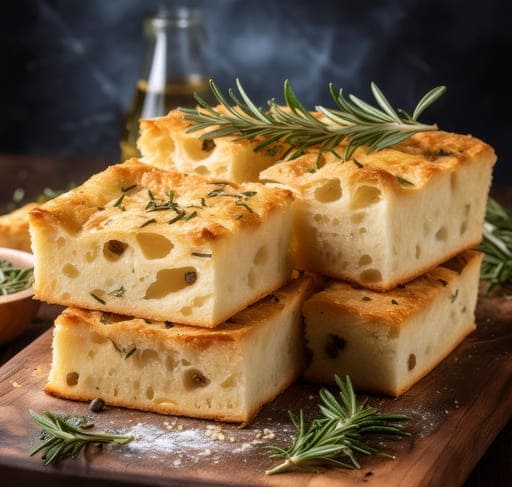Focaccia, the beloved Italian flatbread, is a testament to the beauty of simplicity in baking. Its golden crust, soft interior, and rich olive oil flavor make it a favorite across the world. Now, imagine combining this classic with the tangy, fermented goodness of sourdough discard. Sourdough discard focaccia is not just a delicious way to use up excess starter; it’s a culinary experience that brings together the rustic charm of sourdough with the airy, tender texture of focaccia.
Good
James Beard
bread is the most fundamentally satisfying of all foods; good bread with fresh butter, the greatest of feasts.
Whether you’re looking to impress guests, enhance your dinner table, or simply enjoy a satisfying homemade bread, this recipe offers an easy yet rewarding baking adventure. With just a few ingredients and some patience, you can create a focaccia that’s as flavorful as it is versatile.
Table of Contents

Why You’ll Love This Sourdough Discard Focaccia Recipe
Waste Not, Want Not: This recipe helps you make the most of your sourdough starter, reducing kitchen waste.
Enhanced Flavor: The sourdough discard adds a subtle, tangy depth that complements the traditional olive oil richness of focaccia.
Perfect Texture: Enjoy a crisp, golden crust with a light, airy crumb that’s perfect for dipping, topping, or eating plain.
Customizable: Focaccia is a blank canvas whether you prefer simple rosemary and sea salt or more elaborate toppings like olives and cherry tomatoes, the options are endless.
Beginner-Friendly: Even if you’re new to sourdough or bread baking, this recipe is easy to follow and yields impressive results.

How to Make Sourdough Discard Focaccia
Ingredients
- 1 cup (240g) sourdough discard (unfed)
- 1 1/4 cups (300ml) warm water
- 3 1/2 cups (420g) all-purpose flour
- 1/4 cup (60ml) olive oil (plus more for drizzling)
- 2 teaspoons salt
- 1 teaspoon sugar
- 1 teaspoon instant yeast (optional for quicker rise)
- Coarse sea salt for sprinkling
- Fresh rosemary or other herbs for topping (optional)
Instructions
Activate Yeast (Optional): Mix warm water, sugar, and yeast in a bowl. Let it sit for 5 minutes until foamy. This step is optional but speeds up the process.
Mix Wet Ingredients: In a large bowl, combine sourdough discard with the yeast mixture (or just water if not using yeast) and olive oil. Stir until well mixed.
Combine Dry Ingredients: Add flour and salt to the wet mixture. Stir until a shaggy, slightly sticky dough forms.
Knead the Dough: Knead on a floured surface for 5-7 minutes until smooth and elastic, or use the stretch-and-fold method in the bowl.
First Rise: Place dough in an oiled bowl, cover, and let rise at room temperature for 3-4 hours or overnight in the fridge for stronger flavor.
Shape the Dough: Transfer dough to an oiled pan. Gently stretch and press it to fit, creating deep dimples on the surface.
Second Rise: Cover and let rise for 1-2 hours until puffy. Preheat oven to 425°F (220°C).
Prepare for Baking: Drizzle olive oil over the dough, filling the dimples. Sprinkle with sea salt and preferred toppings.
Bake: Bake for 20-25 minutes until golden brown and crispy. The bread should sound hollow when tapped.
Cool and Serve: Cool in the pan for a few minutes, then transfer to a wire rack. Serve warm or at room temperature, enjoying the chewy texture and rich flavor.

Tips For Sourdough Discard Focaccia
Use Plenty of Olive Oil: Don’t skimp on the olive oil it’s essential for achieving that characteristic focaccia crust and flavor. The oil creates a crisp exterior and adds richness to the bread.
Be Patient with Rising: Allow the dough ample time to rise, especially during the first rise. This helps develop the gluten structure and ensures a light, airy crumb. An overnight rise in the refrigerator will enhance the sourdough flavor.
Create Deep Dimples: The dimples you press into the dough are not just for decoration they help the olive oil and toppings penetrate the bread, adding flavor and texture.
Experiment with Toppings: While rosemary and sea salt are classic choices, don’t be afraid to experiment. Add cherry tomatoes, olives, garlic, caramelized onions, or even thin slices of potato for a gourmet touch.
Store Properly: Focaccia is best enjoyed fresh but can be stored in an airtight container at room temperature for up to 2 days. To reheat, simply warm it in the oven to restore its crispy texture.
Bread is the king of the table and all else is merely the court that surrounds the king.
Louis Bromfield
Sourdough Discard Focaccia Recipe FAQ
How Do You Store Sourdough Focaccia?
To keep sourdough focaccia fresh and delicious, follow these storage tips:
- At Room Temperature:
- Wrap the focaccia tightly in plastic wrap or place it in an airtight container.
- Store it at room temperature for up to 2 days.
- In the Refrigerator:
- Refrigeration is ideal if you need to store focaccia longer than 2 days.
- Wrap it tightly or place it in a sealed container to prevent it from drying out.
- Consume within 4–5 days for the best texture and flavor.
- In the Freezer:
- To freeze focaccia, wrap it tightly in plastic wrap, followed by aluminum foil, or place it in a freezer-safe bag.
- Freeze for up to 3 months. Reheat directly from frozen in the oven at 350°F (175°C) until warm.
How to Know If Sourdough Discard Has Gone Bad?
Signs that sourdough discard has spoiled include:
- Foul Odor:
- A strong, unpleasant smell (like mold or rot) indicates spoilage. A tangy or sour smell is normal.
- Mold:
- Visible mold in the form of green, black, or fuzzy spots means the discard is no longer safe to use.
- Discoloration:
- A pink or orange hue suggests bacterial contamination and spoilage.
- Excessive Liquid:
- While some liquid (hooch) is normal, an unusual amount with a bad smell may indicate the discard is past its prime.
When in doubt, discard it and start fresh.
How Soon Can You Bake with Sourdough Discard?
You can bake with sourdough discard immediately after removing it from your starter, even if it’s unfed. However, consider these points:
- For Recipes That Don’t Require Rising (e.g., Crackers, Pancakes):
Use discard right away without any additional preparation. - For Leavened Recipes (e.g., Bread, Biscuits):
Discard from a recently fed starter (within 1–2 days) will work better for leavening because it has more active yeast.
Refrigerated discard should be brought to room temperature before use for best results.
When to Dimple Focaccia?
You should dimple focaccia right before baking, after the final rise. Here’s the process:
- Let the dough complete its proofing (usually 2–4 hours or overnight in the refrigerator).
- Once it’s risen and bubbly, lightly oil your fingers and press deep dimples into the dough.
- Add toppings or drizzle with olive oil and bake immediately.
What Happens If You Don’t Dimple Focaccia Bread?
If you skip dimpling, the following issues can arise:
- Uneven Baking:
The dough may puff up unevenly in the oven, creating large air pockets or an unbalanced texture. - Flat Flavor Profile:
Dimpling helps toppings and olive oil penetrate the dough, adding flavor and moisture. Without it, the focaccia may taste less seasoned. - Denser Texture:
Dimpling redistributes gases, preventing overly dense areas and ensuring a lighter crumb.
Why Is Focaccia Dimpled Right Before Baking?
Dimpling focaccia serves several purposes:
- Gas Redistribution:
It deflates large air pockets, ensuring an even crumb and preventing the dough from ballooning. - Flavor Integration:
Dimpling allows olive oil, salt, and other toppings to sink into the dough, enhancing flavor throughout. - Moisture Retention:
The dimples hold olive oil, keeping the focaccia moist and tender during baking. - Aesthetic Appeal:
The iconic dimpled surface gives focaccia its signature look.
Dimpling is a crucial step in creating the perfect focaccia texture and flavor!

Sourdough Discard Focaccia: A Chewy and Flavorful Bread
Ingredients
Equipment
Method
- Activate Yeast (Optional): Mix warm water, sugar, and yeast in a bowl. Let it sit for 5 minutes until foamy. This step is optional but speeds up the process.
- Mix Wet Ingredients: In a large bowl, combine sourdough discard with the yeast mixture (or just water if not using yeast) and olive oil. Stir until well mixed.
- Combine Dry Ingredients: Add flour and salt to the wet mixture. Stir until a shaggy, slightly sticky dough forms.
- Knead the Dough: Knead on a floured surface for 5-7 minutes until smooth and elastic, or use the stretch-and-fold method in the bowl.
- First Rise: Place dough in an oiled bowl, cover, and let rise at room temperature for 3-4 hours or overnight in the fridge for stronger flavor.
- Shape the Dough: Transfer dough to an oiled pan. Gently stretch and press it to fit, creating deep dimples on the surface.
- Second Rise: Cover and let rise for 1-2 hours until puffy. Preheat oven to 425°F (220°C).
- Prepare for Baking: Drizzle olive oil over the dough, filling the dimples. Sprinkle with sea salt and preferred toppings.
- Bake: Bake for 20-25 minutes until golden brown and crispy. The bread should sound hollow when tapped.
- Cool and Serve: Cool in the pan for a few minutes, then transfer to a wire rack. Serve warm or at room temperature, enjoying the chewy texture and rich flavor.
Nutrition
Notes
- The yeast is optional but can help speed up the rising process.
- For a stronger sourdough flavor, allow the dough to rise in the fridge overnight.
- Adjust the amount of flour based on the hydration level of your discard.
Calories: 210 | Carbohydrates: 34g | Protein: 5g | Fat: 6g | Saturated Fat: 1g | Polyunsaturated Fat: 0.5g | Monounsaturated Fat: 4.5g | Sodium: 300mg | Potassium: 70mg | Fiber: 1g | Sugar: 1g | Vitamin C: 0mg | Calcium: 10mg | Iron: 2mg
Common Mistakes When Making Sourdough Discard Focaccia
- Skipping the First Rise
- Rushing the first rise leads to dense, less flavorful focaccia. Allow 3–4 hours or an overnight rise for optimal texture and taste.
- Using Too Little Olive Oil
- Skimping on olive oil can result in a dry crust and less flavor. Generously oil the pan and drizzle over the dough for the characteristic richness.
- Not Dimpling the Dough Properly
- Shallow or uneven dimpling prevents the olive oil and toppings from penetrating the dough. Use oiled fingers to press deep, consistent dimples.
- Under- or Over-proofing the Dough
- Under-proofed dough results in a dense texture, while over-proofing causes the dough to collapse. Check for a puffy, well-risen dough during the second rise.
- Overloading Toppings
- Adding too many heavy toppings can weigh down the dough, affecting its rise and bake. Stick to a balance of light herbs, sea salt, and small garnishes.
- Using Cold Ingredients
- Cold water or discard slows down fermentation. Use warm water and bring discard to room temperature to ensure an even rise.
- Not Adjusting for Hydration
- The hydration level of the sourdough discard affects the dough’s consistency. Adjust flour as needed to achieve a slightly sticky but manageable texture.
Conclusion
Sourdough discard focaccia is a perfect fusion of classic Italian breadmaking and the tangy charm of sourdough. Avoid common mistakes like under-proofing, insufficient oil, or neglecting proper dimpling to achieve the ideal airy texture, golden crust, and rich flavor. With its versatility and simplicity, this recipe is a great way to transform sourdough discard into a culinary delight that suits any occasion. Whether topped with rosemary and sea salt or adorned with creative garnishes, focaccia is a satisfying, waste-free baking adventure.
Let me know!
Did you find this post helpful? By leaving a star rating and share, it will help others find my recipes.



